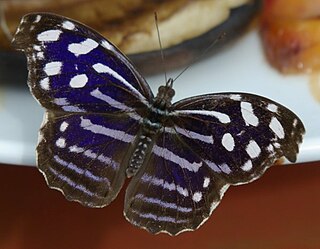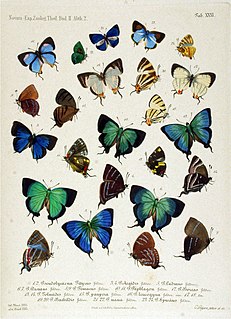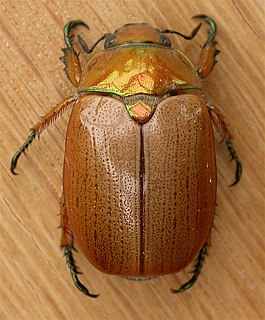Related Research Articles

The Neotropical realm is one of the eight biogeographic realms constituting the Earth's land surface. Physically, it includes the tropical terrestrial ecoregions of the Americas and the entire South American temperate zone.

A biogeographic realm or ecozone is the broadest biogeographic division of Earth's land surface, based on distributional patterns of terrestrial organisms. They are subdivided into ecoregions, which are classified based on their biomes or habitat types.

Myrtaceae or the myrtle family is a family of dicotyledonous plants placed within the order Myrtales. Myrtle, pohutukawa, bay rum tree, clove, guava, acca (feijoa), allspice, and eucalyptus are some notable members of this group. All species are woody, contain essential oils, and have flower parts in multiples of four or five. The leaves are evergreen, alternate to mostly opposite, simple, and usually entire. The flowers have a base number of five petals, though in several genera the petals are minute or absent. The stamens are usually very conspicuous, brightly coloured and numerous.

Zoogeography is the branch of the science of biogeography that is concerned with the geographic distribution of animal species.

The Arctiini are a tribe of tiger moths in the family Erebidae.

The neotropical parrots or New World parrots comprise about 150 species in 32 genera found throughout South and Central America, Mexico, and the Caribbean islands, and two species formerly inhabited North America. They are also present on a few Pacific islands such as the Galápagos. Among them are some of the most familiar and iconic parrots, including the blue and gold macaw, sun conure, and yellow-headed amazon.

Biblidinae is the name for a subfamily of nymphalid butterflies that includes the tropical brushfoots. This subfamily was sometimes merged within the Limenitidinae, but they are now recognized as quite distinct lineages. In older literature, this subfamily is sometimes called Eurytelinae.

The Eumaeini are a tribe of gossamer-winged butterflies. They are typically placed in the subfamily Theclinae, but sometimes considered a separate subfamily Eumaeinae. Over 1,000 species are found in the Neotropical realm

The Haeterini are one of the smaller tribes of the Satyrinae in the Nymphalidae family. The tribe occurs exclusively in tropical rain forests in the Neotropical realm.

The Cochylini are a tribe of tortrix moths. It used to be classified as the subfamily Cochylinae.
The Euliini are a tribe of tortrix moths.

The Ditomyiidae are a small family of flies (Diptera).They are found worldwide, most species are found in the Australasian and Neotropical realms. There are only two genera in Europe Ditomyia Winnertz, 1846 and Symmerus Walker, 1848 Ditomyia is found in Central Europe Symmerus in Northern Europe Symmerus is endemic to the Palaearctic.

Grammitidoideae is a subfamily of the fern family Polypodiaceae, whose members are informally known as grammitids. It comprises a clade of about 750 species. They are distributed over higher elevations in both the Old and New World. This group was previously treated as a separate family, Grammitidaceae until molecular phylogenies showed it to be nested within the Polypodiaceae. It has since been treated as an unranked clade within subfamily Polypodioideae, and, most recently, as a separate subfamily.

The Arini tribe of the neotropical parrots is a monophyletic clade of macaws and parakeets characterized by colorful plumage and long, tapering tails. They occur throughout Mexico, Central America, and South America, and formerly the Caribbean and North America. One genus and several species are extinct; another genus is extinct in the wild. Two species are known only through subfossil remains. About a dozen hypothetical extinct species have been described, native to the Caribbean area. Among the Arini are some of the rarest birds in the world, such as Spix's macaw which is extinct in the wild - fewer than 100 specimens survive in captivity. It also contains the largest flighted parrot in the world, the hyacinth macaw.

Leptochirus is a genus of beetles in the family Staphylinidae, the rove beetles.
Allosorius is a genus of rove beetles.
Neocaledonopsis is a genus of beetles.
Nototorchus is a genus of beetles.

Anoplognathini is a tribe of scarab beetles belonging to the subfamily Rutelinae, a group endemic to the Neotropical and Australian biogeographic realms.
Lobispa is a genus of leaf beetles in the subfamily Eumolpinae. It is known from the Neotropical realm. The genus superficially resembles the subfamily Hispinae, though it is placed in the tribe Cubispini along with Cubispa.
References
- Irmler, U. 2015: New Neotropical genera and species of the tribe Osoriini (Coleoptera: Staphylinidae: Osoriinae). Beiträge zur entomologie (ISSN 0005-805X), 65(1): 173–196. Abstract